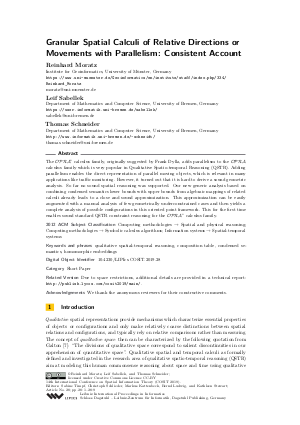Granular Spatial Calculi of Relative Directions or Movements with Parallelism: Consistent Account (Short Paper)
Authors Reinhard Moratz, Leif Sabellek, Thomas Schneider
-
Part of:
Volume:
14th International Conference on Spatial Information Theory (COSIT 2019)
Part of: Series: Leibniz International Proceedings in Informatics (LIPIcs)
Part of: Conference: Conference on Spatial Information Theory (COSIT) - License:
 Creative Commons Attribution 3.0 Unported license
Creative Commons Attribution 3.0 Unported license
- Publication Date: 2019-09-03
File

PDF
LIPIcs.COSIT.2019.28.pdf
- Filesize: 0.48 MB
- 9 pages
Document Identifiers
Related Versions
-
Due to space restrictions, additional details are provided in a technical report: http://publish.lycos.com/cosit2019/main/.
Subject Classification
ACM Subject Classification
- Computing methodologies → Spatial and physical reasoning
- Computing methodologies → Symbolic calculus algorithms
- Information systems → Spatial-temporal systems
Keywords
- qualitative spatial-temporal reasoning
- composition table
- condensed semantics
- homomorphic embeddings
Metrics
- Access Statistics
-
Total Accesses (updated on a weekly basis)
0PDF Downloads0Metadata Views
Abstract
The OPRA* calculus family, originally suggested by Frank Dylla, adds parallelism to the OPRA calculus family which is very popular in Qualitative Spatio-temporal Reasoning (QSTR). Adding parallelism enables the direct representation of parallel moving objects, which is relevant in many applications like traffic monitoring. However, it turned out that it is hard to derive a sound geometric analysis. So far no sound spatial reasoning was supported. Our new generic analysis based on combining condensed semantics lower bounds with upper bounds from algebraic mappings of related calculi already leads to a close and sound approximization. This approximization can be easily augmented with a manual analysis of few geometrically underconstrained cases and then yields a complete analysis of possible configurations in this oriented point framework. This for the first time enables sound standard QSTR constraint reasoning for the OPRA* calculus family.
Cite As Get BibTex
Reinhard Moratz, Leif Sabellek, and Thomas Schneider. Granular Spatial Calculi of Relative Directions or Movements with Parallelism: Consistent Account (Short Paper). In 14th International Conference on Spatial Information Theory (COSIT 2019). Leibniz International Proceedings in Informatics (LIPIcs), Volume 142, pp. 28:1-28:9, Schloss Dagstuhl – Leibniz-Zentrum für Informatik (2019)
https://doi.org/10.4230/LIPIcs.COSIT.2019.28
BibTex
@InProceedings{moratz_et_al:LIPIcs.COSIT.2019.28,
author = {Moratz, Reinhard and Sabellek, Leif and Schneider, Thomas},
title = {{Granular Spatial Calculi of Relative Directions or Movements with Parallelism: Consistent Account}},
booktitle = {14th International Conference on Spatial Information Theory (COSIT 2019)},
pages = {28:1--28:9},
series = {Leibniz International Proceedings in Informatics (LIPIcs)},
ISBN = {978-3-95977-115-3},
ISSN = {1868-8969},
year = {2019},
volume = {142},
editor = {Timpf, Sabine and Schlieder, Christoph and Kattenbeck, Markus and Ludwig, Bernd and Stewart, Kathleen},
publisher = {Schloss Dagstuhl -- Leibniz-Zentrum f{\"u}r Informatik},
address = {Dagstuhl, Germany},
URL = {https://drops.dagstuhl.de/entities/document/10.4230/LIPIcs.COSIT.2019.28},
URN = {urn:nbn:de:0030-drops-111206},
doi = {10.4230/LIPIcs.COSIT.2019.28},
annote = {Keywords: qualitative spatial-temporal reasoning, composition table, condensed semantics, homomorphic embeddings}
}
Author Details
Acknowledgements
We thank the anonymous reviewers for their constructive comments.
References
-
F. Dylla. An agent control perspective on qualitative spatial reasoning: towards more intuitive spatial agent development. PhD thesis, University of Bremen, 2008.

-
F. Dylla and J. H. Lee. A Combined Calculus on Orientation with Composition Based on Geometric Properties. In Proc. of ECAI-10, pages 1087-1088, 2010.

-
F. Dylla, J. H. Lee, T. Mossakowski, T. Schneider, A. van Delden, J. van de Ven, and D. Wolter. A Survey of Qualitative Spatial and Temporal Calculi: Algebraic and Computational Properties. ACM Comput. Surv., 50(1):7:1-7:39, 2017.

-
F. Dylla and R. Moratz. Exploiting Qualitative Spatial Neighborhoods in the Situation Calculus. In Spatial Cognition IV, volume 3343 of LNCS, pages 304-322. Springer, 2004.

-
C. Freksa. Temporal Reasoning Based on Semi-Intervals. Artif. Intell., 54(1):199-227, 1992.

-
C. Freksa. Using Orientation Information for Qualitative Spatial Reasoning. In Proc. of GIS-92, volume 639 of LNCS, pages 162-178. Springer, 1992.

-
A. Galton. Qualitative spatial change. Spatial information systems. Oxford University Press, 2000.

- W. Liu and S. Li. On A Semi-Automatic Method for Generating Composition Tables. CoRR, abs/1105.4224, 2011. URL: http://arxiv.org/abs/1105.4224.
-
R. Moratz. Representing Relative Direction as a Binary Relation of Oriented Points. In Proc. of ECAI-06, pages 407-411, 2006.

-
R. Moratz. Qualitative Spatial Reasoning. In Encyclopedia of GIS, pages 1700-1707. Springer, 2017.

-
R. Moratz, D. Lücke, and T. Mossakowski. A condensed semantics for qualitative spatial reasoning about oriented straight line segments. Artif. Intell., 175(16-17):2099-2127, 2011.

-
R. Moratz, J. Renz, and D. Wolter. Qualitative Spatial Reasoning about Line Segments. In Proc. of ECAI-00, pages 234-238. IOS Press, 2000.

- Reinhard Moratz, Leif Sabellek, and Thomas Schneider. Granular Spatial Calculi of Relative Directions or Movements with Parallelism: Consistent Account. Technical report, University of Münster and University of Bremen, 2019. http://publish.lycos.com/cosit2019/main/.
-
T. Mossakowski and R. Moratz. Qualitative reasoning about relative direction of oriented points. Artif. Intell., 180-181:34-45, 2012.

-
T. Mossakowski and R. Moratz. Relations Between Spatial Calculi About Directions and Orientations. J. Artif. Intell. Res., 54:277-308, 2015.

-
D. Wolter, F. Dylla, S. Wölfl, J. O. Wallgrün, L. Frommberger, B. Nebel, and C. Freksa. SailAway: Spatial Cognition in Sea Navigation. KI, 22(1):28-30, 2008.

